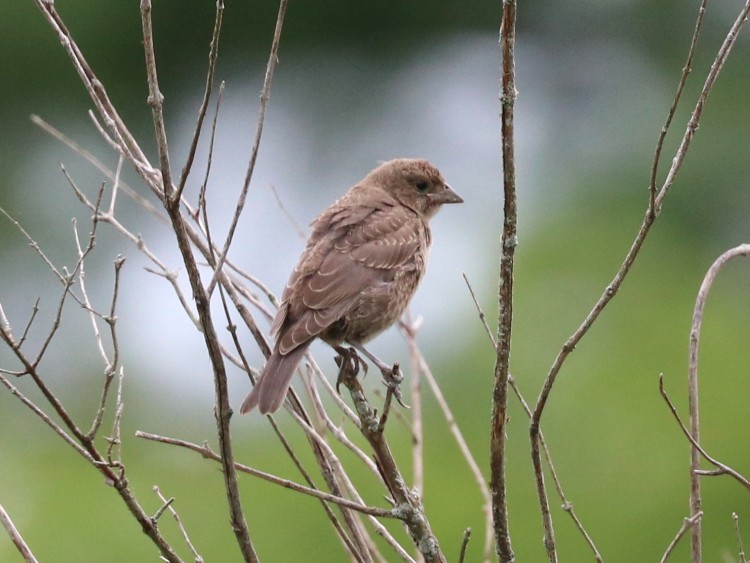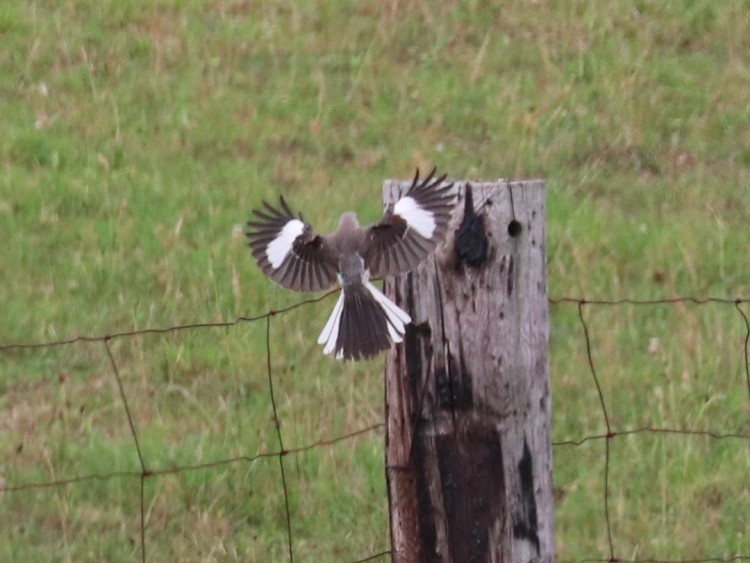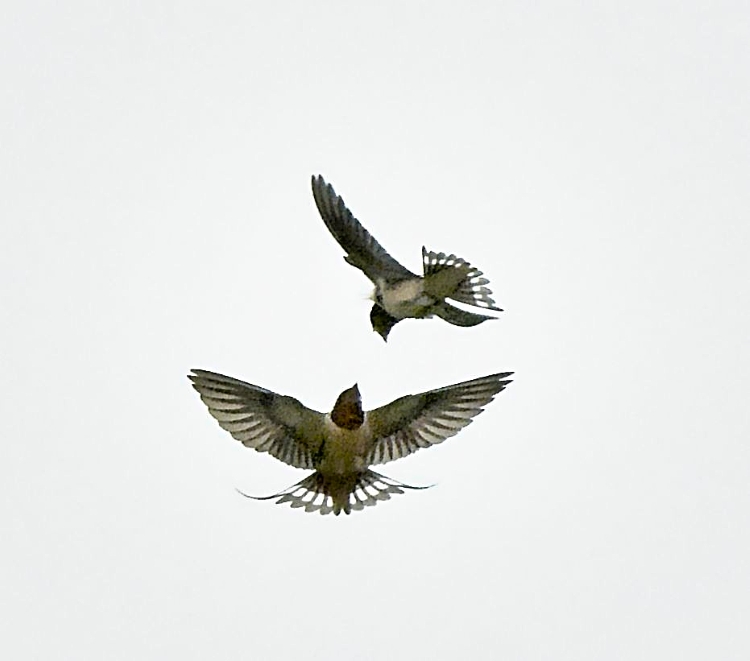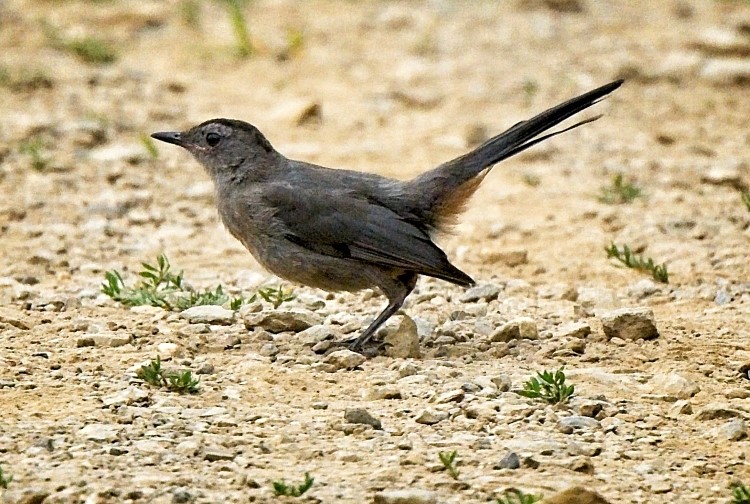For WMB this week, I met birders and co-leaders Dave Williams and Susan Yurkus at Woodsom Farm in Amesbury. We have tried to make at least one trip there in recent years to see the big population of Bobolinks that breed there, and the small, but significant number of Eastern Meadowlarks that breed there as well. We have worked with the City of Amesbury to offer management practices that would enhance the breeding success of grassland birds, and the big field where dog-walkers roam is a truly impressive site for those species.

The part of the breeding season when males display has passed, and fledglings of almost all the birds we encountered were everywhere. At first it seemed that the Bobolinks were gone, but they began to appear in little groups, mostly staying in the grass. We had two sessions this week to accommodate demand, and in the second “shift” more Bobolinks made appearances, taking long, low flights to disappear back into the tall “substrate” of chest-high grasses. Juvenile birds could be seen with adults, often when they were perched high on grass stems feeding on the ripe seed. It is possible that all the Bobolinks that bred or were raised are still there, and that they are particularly cryptic now as they fatten up for migration.

We never saw or heard any Eastern Meadowlarks, so they either have already begun migration, or are even more cryptic than the Bobolinks. There was plenty of action from the birds that don’t hide, however. The fence line with the large posts that extends into the fields was the site of at least one family of Northern Mockingbirds, which were catting about and flashing their wing patches prolifically. Gray Catbirds stayed more hidden in the young trees along the road through the fields, until they didn’t, as one family group spilled out onto the road in a ruckus. American Goldfinches and Cedar Waxwings flitted about in the fields to the right of the trail studded with forbs and small shrubs. Red-winged Blackbirds and Barn Swallows were ubiquitous.

The mostly loose flocks of swallows were full of juvenile birds, and they sometimes coalesced into more organized and synchronous groups in which we could see apparent skirmishes between conspecifics. In their breeding colonies they are known for rather nasty territorial squabbles. During the second session, the fields filled with migrating swallows of four species, including Barn, Tree, Northern Rough-winged, and Banks Swallows. Tree Swallows are beginning to gather on coastal islands and any sites that host maritime shrub habitats containing their almost unique migratory fuel, bayberries. They are beginning to roost in the tops of Phragmites east of North Pool on the Parker River National Wildlife Refuge, for instance, an annual spectacle that will reach its crescendo later in the season with hundreds of thousands of birds covering perches like blankets. Right now they are in the high hundreds and low thousands according to reports on Tom Wetmore’s page, with a high a few days ago of 4000+ reported by the great man himself.

Birding at sites like the Great Marsh, the Atlantic Ocean, and large grasslands rewards patience. When you stand and watch for a good long time, patterns appear, such as the stealthy way the Bobolinks were using their habitat, the prolific and seemingly unconcerned way Red-winged Blackbirds acted just as they did earlier in the season, with even juvenile birds taking occasional slow showy flights. One wonders if those were males born this year who already wanted to try to act like “Dad.” The adult males were done with all that, but it was clear that RWBl’s were less concerned about concealment than Bobolinks. The swallows throw a net of aerial insectivory over the entire habitat, but it is really the migratory birds that cover the area in a way that appears to intentionally “fill in the cracks.”

Our species list is short, but the things we watched the birds doing made up for a lack of species diversity. The questions of “Why this and why that?”, of “Is that what we are really seeing?” flow with the spectacle of so many kinds of former reptiles exhibiting feats of perfect skill, almost whimsical grace, and never-ending surprise. One of the layers of the complex scientific concept of biodiversity is how organisms behave in a given environment, and we observed enough “hows” to imagine launching several PhD dissertations. Thankfully, we may simply muse on such questions as we absorb the beauty.

Our lists: numbers = 7:30 am, 9:30 am
Mourning Dove 5, 12
Chimney Swift 0, 1
Ruby-throated Hummingbird 0, 1
Great Blue Heron 0, 1-2
Cooper’s Hawk 1, 0
Downy Woodpecker 1, 0
Northern Flicker 1, 1
Willow Flycatcher 1, 1
Eastern Phoebe 1, 2
Blue Jay 1, 4
American Crow 0, 5
Bank Swallow 0, 1
Tree Swallow 3, 15
Northern Rough-winged Swallow 0, 2
Barn Swallow 25, 40
White-breasted Nuthatch 1, 0
House Wren 1, 0
Carolina Wren 1, 1
Eastern Bluebird 5, 5
American Robin 5, 8
Gray Catbird 3, 5
Northern Mockingbird 12, 13
European Starling 10, 30
Cedar Waxwing 2, 2
House Sparrow 1, 1
House Finch 2, 0
American Goldfinch 5, 10
Chipping Sparrow 1, 0
Savannah Sparrow 1, 1
Song Sparrow 9, 10
Bobolink 12, 20
Red-winged Blackbird 35, 30
Brown-headed Cowbird 1
Common Yellowthroat 1
Scarlet Tanager 1
Northern Cardinal 1, 2


Love the weekly reports. Even tho’ I’m far away now, I feel like I’m still birding in Newburyport and surrounds!
I love this site and am so pleased with the great partnership between MAS and Woodsom Farm. Meadowlark numbers have decreased so substantially – it’s wonderful to know that they have a protected place!
Hope to see you out birding someday – I miss everyone from Joppa.